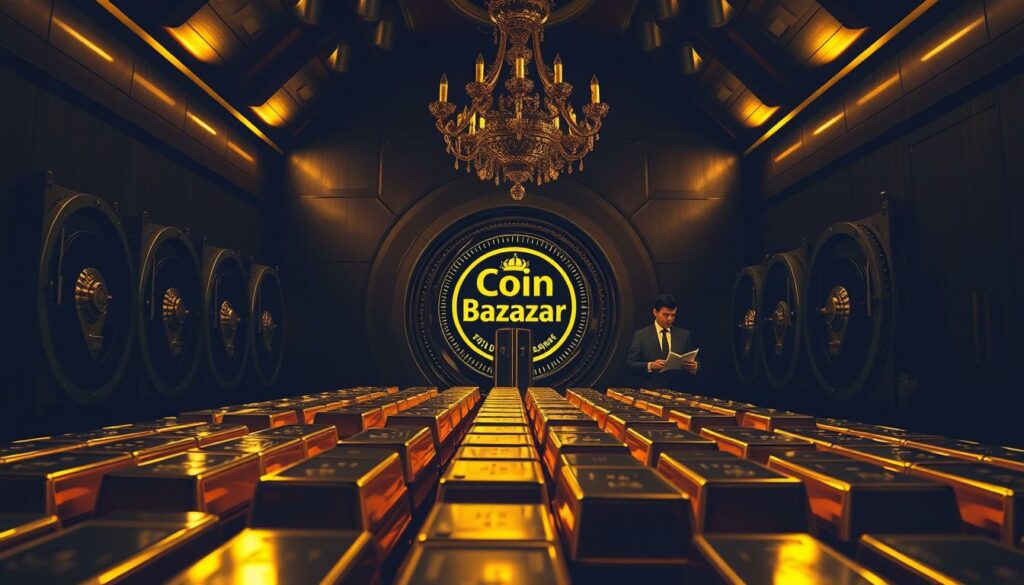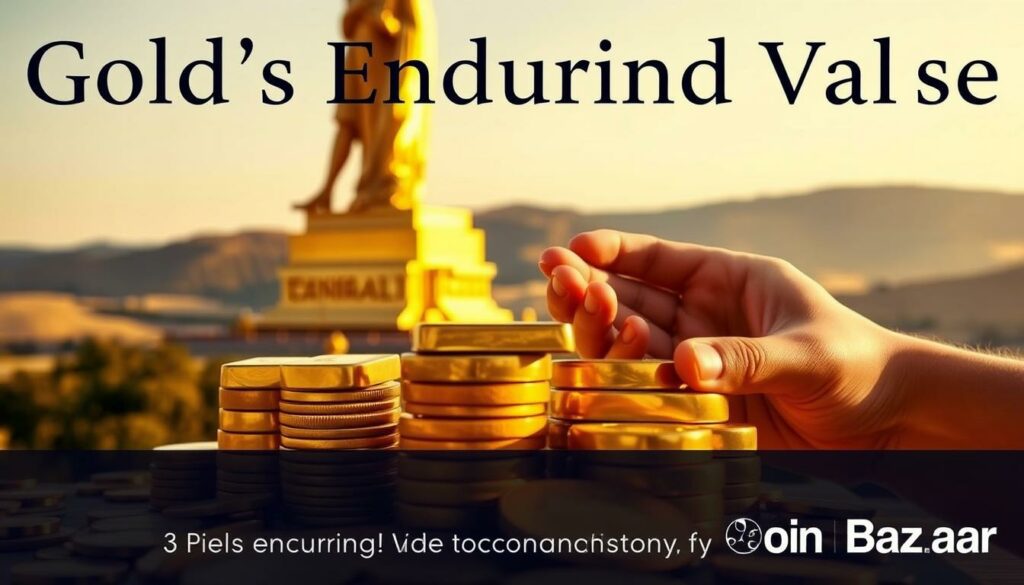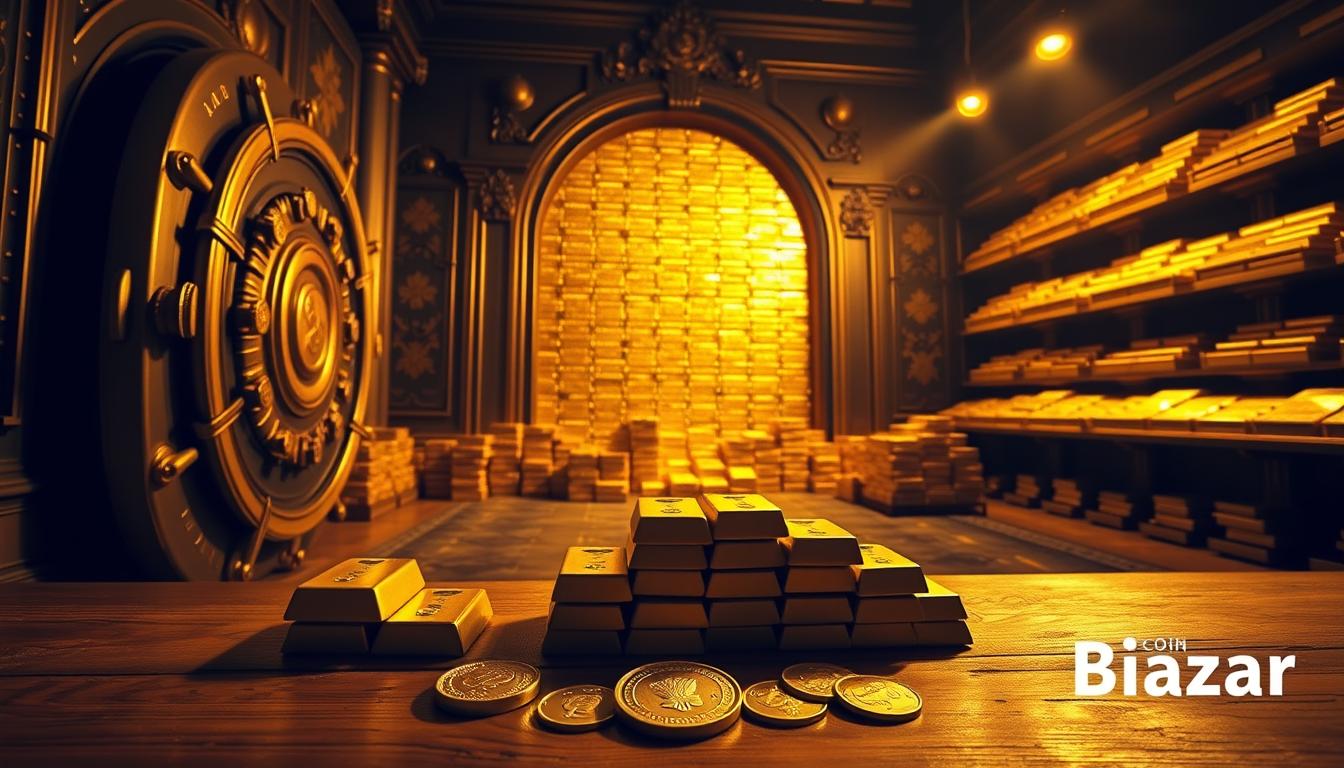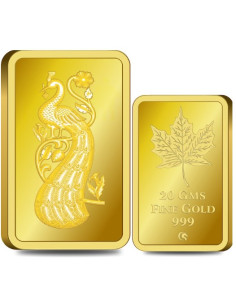Exclusive Deals & Trending Items
Did you know that the world’s central banks are buying a lot of gold? In 2023, they bought a record 1,200 tonnes. Countries like China, Russia, and India are leading this trend.
So, why are they doing this? They’re stockpiling gold to strengthen their economies and ensure economic stability. By adding gold to their reserves, they’re getting ready for a future that’s full of uncertainty.
This move is really important. Let’s look into why these countries want to build up their gold reserves. You’ll learn more about the global economy and how it affects you.
Key Takeaways
- Global central banks bought a record 1,200 tonnes of gold in 2023.
- China, Russia, and India are leading the gold-buying spree.
- Stockpiling gold is a strategy for economic stability.
- Diversifying reserves is a key motivator for central banks.
- The gold rush is driven by a desire for a more secure economic future.
The Modern Gold Rush: Central Banks Leading the Charge
A new era of gold accumulation is underway. Central banks are leading the charge, reshaping international finance. You’re seeing a big shift in how nations manage their financial reserves. Gold is now the top choice.
Record-Breaking Gold Acquisitions in Recent Years
Central banks are buying gold at an unprecedented rate. Countries like China and Russia are leading the way. They’ve been adding a lot to their gold reserves.
Notable Purchases That Made Headlines
China has boosted its gold reserves by over 75% since 2009. Russia’s central bank has bought over 2,000 tonnes since 2008. These moves have strengthened their reserves and sent a strong message to the global market.
Comparing Current Trends to Historical Patterns
The current gold rush reminds us of times when gold was key during economic uncertainty. But the scale and speed of today’s buying are unmatched.


| Country | Gold Reserves Increase | Period |
|---|---|---|
| China | 75% | Since 2009 |
| Russia | Over 2,000 tonnes | Since 2008 |
The trend is clear: central banks are stockpiling gold. They want to diversify their reserves and reduce economic risks. As you follow this trend, it’s key to understand its impact on the global economy and gold prices.
Gold’s Enduring Value Through Economic History
Gold’s value has always been important to central banks, especially when the economy is shaky. It’s not just a commodity; it plays a big role in shaping money policies.


From Gold Standard to Fiat Currency Systems
The move from the gold standard to fiat currency was a big change in money history. The gold standard, where money was backed by gold, ended in 1971. This led to a new way of making money policies.
The Bretton Woods Agreement and Its Collapse
The Bretton Woods Agreement, made in 1944, aimed to stabilize the world’s money. It tied currencies to the US dollar, which could be exchanged for gold. But, the US’s growing debt and inflation problems made it fail in 1971.
Post-1971 Monetary System Changes
After Bretton Woods fell apart, the world moved to a fiat currency system. Now, money’s value comes from supply and demand, not gold. This change has made money policies more flexible but also brought new challenges like controlling inflation.
Central banks keep buying gold, showing it’s still key to their reserves. They want to diversify and protect against economic risks.
In summary, gold’s lasting value comes from its history and its role in today’s money systems. Understanding gold’s role can help you see how central banks work and what it means for your investments.
Understanding the Central Banks Gold Rush Phenomenon
What’s behind the big jump in gold reserves by central banks around the world? It’s a mix of things like economic stability, global tensions, and wanting to spread out their assets.
Global Trends in Official Gold Reserves
Central banks all over are buying more gold. Emerging markets are leading the way. They want to grow their economic power and not rely so much on the US dollar.
Statistical Analysis of Reserve Growth
Central banks have been adding to their gold reserves for ten years. The increase has been especially fast in the last few years. This trend is likely to keep going as they try to balance their assets and avoid risks.
Regional Differences in Acquisition Patterns
Even though the trend is clear, there are differences by region. For example, Asian central banks are very active, especially China and India. But European central banks are more careful with their gold purchases.
It’s important to understand these regional differences. As the world economy changes, central banks will keep influencing gold demand.
Economic Uncertainty: The Primary Driver of Gold Accumulation
Central banks worldwide are buying gold at a record pace. This move is mainly because of economic uncertainty. Knowing how gold fits into their plans can help you understand the financial world better.
Protection Against Inflation and Currency Devaluation
Gold is seen as a safe investment, protecting against inflation and currency loss. As the economy becomes more unstable, gold becomes more attractive. Central banks are now using gold to strengthen their reserves.
Gold’s Performance During High Inflation Periods
In times of high inflation, gold has shown its worth. For example, in the 1970s, when inflation was high, gold prices soared. This shows gold can be a good hedge against currency loss in the future.
Case Studies of Currency Crises and Gold Prices
Gold has also proven valuable during currency crises. For instance, during the Asian financial crisis in the late 1990s, gold prices went up. This shows gold’s role as a safe asset during economic troubles.
Learning about central banks’ gold purchases can guide your investment choices. The evidence is clear: in uncertain times, gold is a reliable asset.
De-Dollarization: Reducing Dependence on the US Dollar
De-dollarization is a big trend as countries want to spread out their reserves. You might be curious about its impact on global economies and money policies. It’s about cutting down on the US dollar in international deals and reserves.
The Dollar’s Dominance in International Reserves
The US dollar has been key for international reserves for a long time. This has been a big part of global money policy for decades. But, things are starting to change.
Historical Development of the Dollar Reserve System
The dollar’s power grew after World War II, thanks to the Bretton Woods system. This history is key to understanding the dollar’s current role. Even when the system fell apart in the 1970s, the dollar kept getting stronger. This was thanks to the US’s strong economy and global influence.
Challenges to Dollar Supremacy in Recent Years
Recently, there have been big challenges to the dollar’s top spot. Central banks are spreading out their reserves because of world tensions and wanting more control over money. The growth of Asian economies is also pushing for change.
The shift towards less US dollar use shows the global economy is changing. This move towards more variety and safety in the face of economic uncertainty is clear. Investing in precious metals, like gold, is becoming more popular as part of this strategy.
China’s Gold Strategy: Building Strength Silently
China is quietly growing its gold reserves. This move is part of a bigger plan to make its economy stronger and less dependent on foreign money.
Official vs. Estimated Actual Gold Holdings
The People’s Bank of China (PBOC) has been adding to its gold reserves. This makes China the sixth-largest gold holder worldwide. But, there’s a gap between what the government says and what’s really there.
Transparency Issues in Chinese Gold Reporting have raised concerns. The unclear data on gold transactions and reserves makes it hard to know how much gold China really has.
Transparency Issues in Chinese Gold Reporting
The mystery around China’s gold reserves is a big problem. “The lack of transparency in China’s gold reporting makes it difficult to assess the true extent of its gold holdings.” This lack of clarity can cause market speculation and volatility.
Domestic Gold Production and Import Figures
China is getting gold not just from buying it but also from its own mines and imports. The country’s gold production is increasing, adding to its reserves.
As China continues to build its gold reserves, it’s important to watch both official and estimated gold reserves. China’s gold strategy is key to its economic planning, showing its commitment to financial stability and security.
“China’s gold buying spree is a strategic move to diversify its reserves and reduce its dependence on the US dollar.”
In conclusion, China’s gold strategy is complex, involving different ways to get gold. It’s crucial for investors and economists to understand the details of China’s gold holdings.
Russia’s Gold Accumulation: Sanctions-Proofing the Economy
Since 2014, Russia has been buying a lot of gold. This is to protect its economy from being cut off financially. Gold is seen as a safe asset and a way to guard against economic ups and downs.
Response to Western Financial Restrictions
Russia is buying gold to shield its economy from Western sanctions. This move makes its economy stronger and less dependent on the US dollar.
Post-2014 Acceleration in Gold Purchases
After 2014, Russia really stepped up its gold buying. This was a response to sanctions from Western countries. As a result, Russia’s gold reserves have grown a lot, helping its economy stay stable.
| Year | Gold Reserves (Tonnes) | Change |
|---|---|---|
| 2014 | 1,200 | – |
| 2018 | 1,800 | +50% |
| 2022 | 2,300 | +28% |
Gold as a Sanction-Resistant Asset
Gold is not controlled by any government or financial system. This makes it a great asset for countries under sanctions. The Economist said, “Gold is the ultimate safe-haven asset, and in times of economic uncertainty, its value becomes particularly evident.”
“In a world of increasing financial fragmentation, gold is likely to play an even more significant role as a reserve asset.”
Many countries are looking at their gold reserves again because of global economic changes. Gold is becoming more important in national economic plans.
By buying gold, Russia is preparing for possible future sanctions. This move makes Russia’s economy stronger and shows gold’s key role in the global economy.
India’s Growing Gold Reserves: Cultural and Economic Significance
India’s growing gold reserves show the country’s deep love for gold. It’s known as one of the biggest gold consumers. This demand comes from both cultural traditions and economic reasons.
Traditional Gold Affinity in Indian Society
Gold is very important in Indian culture, especially at weddings and festivals. Giving gold jewelry as gifts during these times is a long tradition. It means good luck and wealth.
Gold in Indian Cultural and Religious Practices
In many Indian homes, gold is seen as a sign of wealth and luck. It’s often used in religious events and as part of dowries in marriages. As Rabindranath Tagore said, “The earth has music for those who listen.” For Indians, gold is like a timeless melody that connects generations, showing that “gold is a treasure that never loses value.”
“Gold is a treasure, and it is a symbol of wealth, not just in India, but across the world. It’s a form of insurance against uncertain economic times.” –
Private Gold Holdings and Their Economic Impact
Many Indian families keep gold, whether in jewelry or coins. This large amount of gold has big economic effects. It can change how much gold is demanded and, thus, affect global gold prices.
Gold’s role in India goes beyond just money. It’s a key part of the country’s culture and traditions.
The impact of gold on India’s economy is wide-ranging. It affects the country’s trade balance because of big imports. It also changes the rupee’s value against the dollar. Plus, choosing gold as an investment means less money for other investments, shaping the investment scene.
The BRICS Nations: Coordinated Gold Strategies
BRICS nations are working together to align their gold reserves. This could change the world’s money system. It’s a big move in global economics.
Potential for Gold-Backed BRICS Currency
There’s talk about a gold-backed currency among BRICS. This idea has come up at recent meetings. It could change how money works worldwide.
Discussions and Proposals at BRICS Summits
At BRICS summits, countries are talking about a gold-backed currency. This could help reduce the dollar’s power and make finances more stable. They’re thinking about a shared currency for trade among BRICS.
Technical Challenges and Implementation Possibilities
But, there are big technical hurdles to cross. Like figuring out gold’s value, managing reserves, and keeping the currency stable. With careful planning, these issues can be solved. This could lead to a more stable money system globally.
| BRICS Country | Gold Reserves (Tonnes) | Potential Contribution to Gold-Backed Currency |
|---|---|---|
| Brazil | 67.3 | Moderate |
| Russia | 2330 | High |
| India | 754.1 | Significant |
| China | 2134 | High |
| South Africa | 125.3 | Moderate |
The table shows Russia and China have a lot of gold. This could help a lot in making a gold-backed currency. BRICS working together could really change the world’s economy.
Impact of Central Bank Buying on Global Gold Prices
Central banks buying gold has made a big difference in gold prices worldwide. You might be curious about how this affects your investments. The trend is clear: central banks are buying gold at an unprecedented rate. This has big implications for the global economy.
Price Trends During Periods of Heavy Central Bank Acquisition
When central banks buy a lot of gold, gold prices often go up. This is not just a coincidence. The demand from central banks directly leads to higher prices. Let’s look at how official purchases affect gold prices.
Statistical Correlation Between Official Purchases and Price Movements
Research shows a strong link between central bank gold purchases and gold price trends. For example, when central banks buy a lot, gold prices tend to rise. The table below shows this connection over the last decade.
| Year | Central Bank Gold Purchases (Tonnes) | Gold Price at Year-End (USD/Oz) |
|---|---|---|
| 2013 | 408 | 1,204 |
| 2014 | 578 | 1,206 |
| 2015 | 566 | 1,060 |
| 2016 | 417 | 1,159 |
| 2017 | 374 | 1,296 |
| 2018 | 656 | 1,282 |
| 2019 | 574 | 1,517 |
| 2020 | 590 | 1,864 |
| 2021 | 450 | 1,806 |
| 2022 | 474 | 1,824 |
Market Reactions to Announced Reserve Increases
When central banks say they’re increasing their gold reserves, the market usually gets excited. This excitement makes gold prices go up. This is because gold is seen as a safe and valuable asset. The chart below shows how these announcements affect gold prices, even though the chart isn’t here, the description explains the positive effect.
In conclusion, central bank buying has a big impact on gold prices worldwide. Understanding this can help you make better investment choices. It gives you insight into what might happen with gold prices in the future.
Gold Mining and Production: Meeting the Growing Demand
Central banks are buying more gold, leading to a new era in mining. The demand for gold keeps going up. This is making the gold mining industry work harder to meet that need.
Major Gold Producing Countries and Their Output
A few countries lead the way in gold mining. China, Australia, and the United States are at the top. Their gold production greatly affects the global trends.
Top Producers and Their Reserve Estimates
- China: China’s gold mining is huge, with lots of gold reserves.
- Australia: Australia mines a lot of gold, thanks to many mines across the country.
- United States: The U.S. mines a lot of gold, especially in Nevada and Alaska.
Production Trends and Peak Gold Theory
The gold mining world faces trends and challenges. The peak gold theory is a big debate. It says gold production will hit a peak and then go down.
Some think new tech will keep production up. Others believe the best gold spots have already been found.
Now, production trends show both growth and hurdles. Some mines are finding less gold, but new finds and better ways to mine are helping keep production steady.
Private Investment Implications: Following Central Banks’ Lead
Watching central banks buy gold might make you think about adding gold to your investments. Their big gold purchases are more than just keeping reserves. They send a message that can guide your investment choices.
How Individual Investors Can Respond to the Gold Rush
Individual investors can follow central banks by adding gold to their portfolios. You can buy physical gold, invest in gold ETFs, or get shares in gold mining companies.
Lessons from Central Bank Investment Strategies
Central banks buy gold for its stability and as a protection against inflation and currency loss. You can do the same by setting aside some of your portfolio for gold. This can help protect against market ups and downs.
Timing Your Gold Investments Based on Central Bank Activities
It’s hard to perfectly time the market based on central bank gold purchases. But, watching their trends can give you useful hints. For example, if central banks keep buying more gold, it might mean a long-term move towards safer investments.
| Investment Strategy | Description | Benefit |
|---|---|---|
| Physical Gold | Buying gold coins or bars | Tangible asset, easy to liquidate |
| Gold ETFs | Investing in gold exchange-traded funds | Convenient, doesn’t require physical storage |
| Gold Mining Stocks | Investing in shares of gold mining companies | Potential for higher returns, exposure to gold price |
By understanding why central banks buy gold and using similar strategies, you can make better choices for your gold investments.
The Future of Gold in the International Monetary System
Central banks around the world are buying more gold. This has people talking about using gold-backed currencies again. You might be curious about how this could change the global money system.
Gold is being stockpiled by countries like China, Russia, and India. This has started a big debate. Some think we might go back to using gold-backed currencies.
Potential Return to Gold-Backed Currencies
The idea of gold-backed currencies is getting more attention. This is because of economic worries and the drop in value of regular money. Gold-backed currencies are seen as more stable and trustworthy when the economy is shaky.
Historical Lessons from Previous Gold Standards
Gold standards have kept money stable in the past. For example, the gold standard helped keep money stable in the 19th and early 20th centuries. But, it also limited how governments could control money, leading to its end.
You can learn from history that gold standards bring stability but also have limits.
Modern Proposals for Gold-Linked Monetary Systems
Today, there are new ideas for combining gold with modern money systems. Some suggest using a mix where money is partly backed by gold. This would offer both stability and the ability to change money policies. Thinking about gold’s role in the future shows we need big changes in global policies and cooperation.
In summary, gold’s role in the world’s money system might change with the return to gold-backed currencies. Understanding history and new ideas helps us see what this means for the global economy.
Conclusion: The Golden Path Forward in Global Economics
Central banks are buying gold at a record pace. This move is aimed at achieving economic stability and possibly reducing reliance on the US dollar. Understanding gold’s role in the international monetary system is key.
Gold accumulation by countries like China, Russia, and India shows a strategic shift. They want to diversify and lessen their US dollar dependence. This could lead to a more balanced currency system globally.
Gold’s role in global economics is set to grow. It offers stability and protects against inflation and currency value drops. Gold will likely stay a crucial part of the world’s monetary system.




















